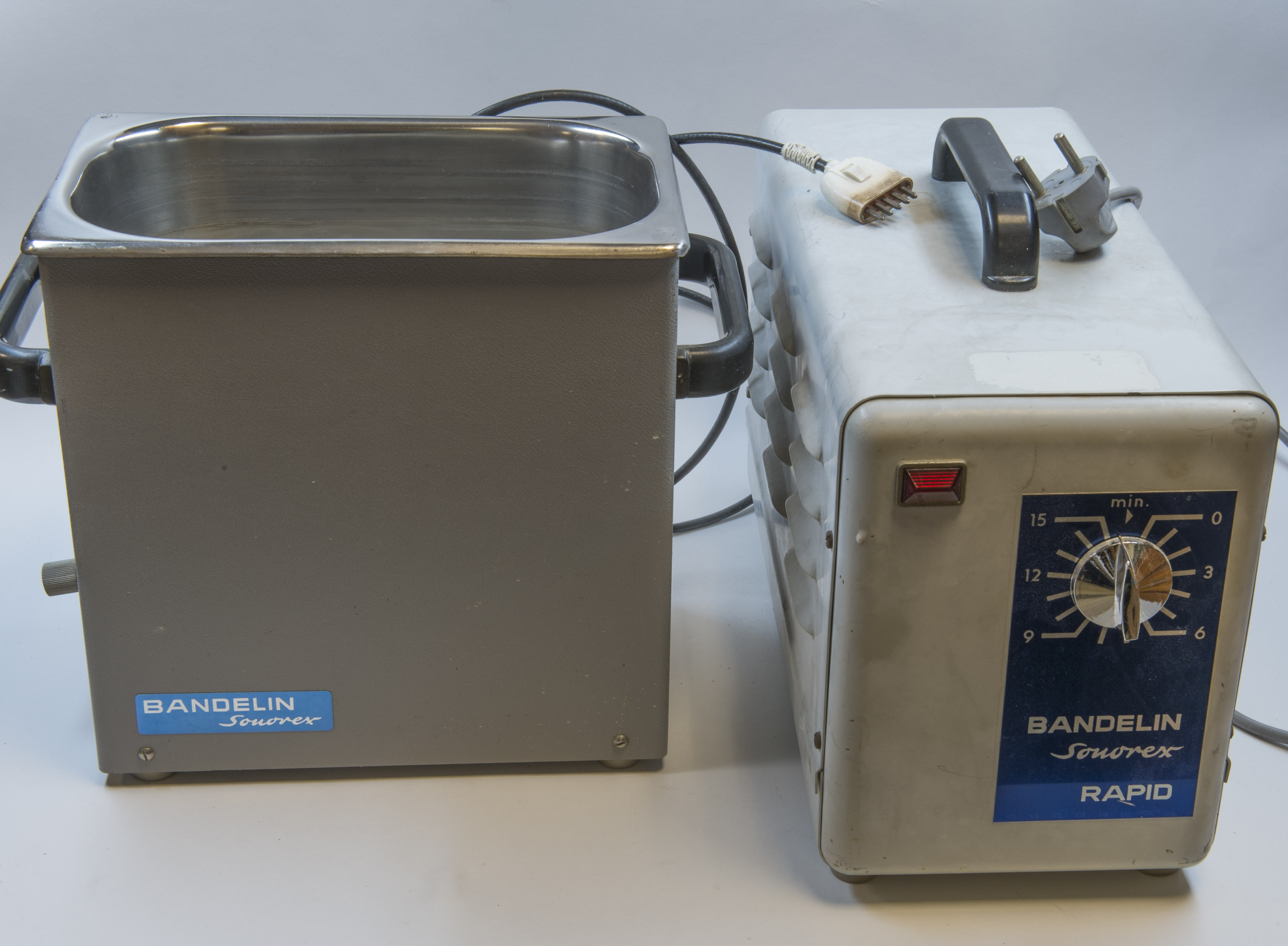|
Ultrasound Assisted Extraction
A sonicator at the Weizmann Institute of Science during sonicationSonication is the act of applying sound energy to agitate particles in a sample, for various purposes such as the extraction of multiple compounds from plants, microalgae and seaweeds. Ultrasonic frequencies (> 20 kHz) are usually used, leading to the process also being known as ultrasonication or ultra-sonication. In the laboratory, it is usually applied using an ''ultrasonic bath'' or an ''ultrasonic probe'', colloquially known as a ''sonicator''. In a paper machine, an ultrasonic foil can distribute cellulose fibres more uniformly and strengthen the paper. Effects Sonication has numerous effects, both chemical and physical. The scientific field concerned with understanding the effect of sonic waves on chemical systems is called sonochemistry. The chemical effects of ultrasound do not come from a direct interaction with molecular species. Studies have shown that no direct coupling of the acoustic f ... [...More Info...] [...Related Items...] OR: [Wikipedia] [Google] [Baidu] |
Sparging (chemistry)
In chemistry, sparging, also known as gas flushing in metallurgy, is a technique in which a gas is bubbled through a liquid in order to remove ''other'' dissolved gas(es) and/or dissolved volatile liquid(s) from that liquid. It is a method of degassing. According to Henry's law, the concentration of each gas in a liquid is proportional to the partial pressure of that gas (in the gaseous state) in contact with the liquid. Sparging introduces a gas that has little or no partial pressure of the gas(es) to be removed, and increases the area of the gas-liquid interface, which encourages some of the dissolved gas(es) to diffuse into the sparging gas before the sparging gas escapes from the liquid. Many sparging processes, such as solvent removal, use air as the sparging gas. To remove oxygen, or for sensitive solutions or reactive molten metals, a chemically inert gas such as nitrogen, argon, or helium is used. Liquid chromatography Solvents used in high-performance liquid chromatogr ... [...More Info...] [...Related Items...] OR: [Wikipedia] [Google] [Baidu] |
Phenols
In organic chemistry, phenols, sometimes called phenolics, are a class of chemical compounds consisting of one or more hydroxyl groups (− O H) bonded directly to an aromatic hydrocarbon group. The simplest is phenol, . Phenolic compounds are classified as simple phenols or polyphenols based on the number of phenol units in the molecule. Phenols are both synthesized industrially and produced by plants and microorganisms. Properties Acidity Phenols are more acidic than typical alcohols. The acidity of the hydroxyl group in phenols is commonly intermediate between that of aliphatic alcohols and carboxylic acids (their pKa is usually between 10 and 12). Deprotonation of a phenol forms a corresponding negative phenolate ion or phenoxide ion, and the corresponding salts are called phenolates or phenoxides (aryloxides, according to the IUPAC Gold Book). Condensation with aldehydes and ketones Phenols are susceptible to electrophilic aromatic substitutions. Condensation with ... [...More Info...] [...Related Items...] OR: [Wikipedia] [Google] [Baidu] |
Soybean
The soybean, soy bean, or soya bean (''Glycine max'') is a species of legume native to East Asia, widely grown for its edible bean. Soy is a staple crop, the world's most grown legume, and an important animal feed. Soy is a key source of food, useful both for its protein and oil content. Soybean oil is widely used in cooking, as well as in industry. Traditional unfermented food uses of soybeans include edamame, as well as soy milk, from which tofu and tofu skin are made. Fermented soy foods include soy sauce, fermented bean paste, nattō, and tempeh. Fat-free (defatted) soybean meal is a significant and cheap source of protein for animal feeds and many packaged meals. For example, soybean products, such as textured vegetable protein (TVP), are ingredients in many meat and dairy substitutes. Soy based foods are traditionally associated with East Asian cuisines, and still constitute a major part of East Asian diets, but processed soy products are increasingly used ... [...More Info...] [...Related Items...] OR: [Wikipedia] [Google] [Baidu] |
Isoflavone
Isoflavones are a type of naturally-occurring isoflavonoids, many of which act as phytoestrogens in mammals. Isoflavones occur in many plant species, but are especially high in soybeans. Although isoflavones and closely-related phytoestrogens are sold as dietary supplements, there is little scientific evidence for either the safety of long-term supplementation or of health benefits from these compounds. Some studies indicate that isoflavone supplementation may help lower the risk of hormone-related cancers. Organic chemistry and biosynthesis Isoflavone is an isomer of flavone, which is chromone substituted with a phenyl group in the 2-position. In isoflavone, the phenyl group is in the 3-position. Substituted isoflavone derivatives are related to the parent by the replacement of two or three hydrogen atoms with hydroxyl groups. Isoflavone differs from flavone (2-phenyl-4''H''-1-benzopyr-4-one) in location of the phenyl group. Isoflavones are produced via a branch of the ... [...More Info...] [...Related Items...] OR: [Wikipedia] [Google] [Baidu] |
Ultrasonic Bath
Ultrasonic cleaning is a process that uses ultrasound (usually from 20 to 40 kHz) to agitate a fluid, with a cleaning effect. Ultrasonic cleaners come in a variety of sizes, from small desktop units with an internal volume of less than , to large industrial units with volumes approaching 1,000 litres (260 US gal). The principle of the ultrasonic cleaning machine is to convert the sound energy of the ultrasonic frequency source into mechanical vibration through the transducer. The vibration generated by the ultrasonic wave is transmitted to the cleaning liquid through the cleaning tank wall so that the micro-bubbles in the liquid in the tank can keep vibrating under the action of the sound wave, destroying and separating the dirty adsorption on the surface of the object. Depending on the object being cleaned, the process can be very rapid, completely cleaning a soiled item in minutes. In other instances, cleaning can be slower, and exceed 30 minutes. Ultrasonic cleaners are used ... [...More Info...] [...Related Items...] OR: [Wikipedia] [Google] [Baidu] |
Micropaleontology
Micropaleontology (American spelling; spelled micropalaeontology in European usage) is the branch of paleontology (palaeontology) that studies microfossils, or fossils that require the use of a microscope to see the organism, its morphology and its characteristic details. Microfossils Microfossils are fossils that are generally between 0.001mm and 1 mm in size, the study of which requires the use of light or electron microscopy. Fossils which can be studied by the naked eye or low-powered magnification, such as a hand lens, are referred to as macrofossils. For example, some colonial organisms, such as Bryozoa (especially the Cheilostomata) have relatively large colonies, but are classified by fine skeletal details of the small individuals of the colony. In another example, many fossil genera of Foraminifera, which are protists are known from shells (called "tests") that were as big as coins, such as the genus '' Nummulites''. Microfossils are a common feature of th ... [...More Info...] [...Related Items...] OR: [Wikipedia] [Google] [Baidu] |
Soil Organic Matter
Soil organic matter (SOM) is the organic matter component of soil, consisting of plant and animal detritus at various stages of decomposition, cells and tissues of soil microbes, and substances that soil microbes synthesize. SOM provides numerous benefits to soil's physical and chemical properties and its capacity to provide regulatory ecosystem services. SOM is especially critical for soil functions and quality. The benefits of SOM result from several complex, interactive, edaphic factors; a non-exhaustive list of these benefits to soil function includes improvement of soil structure, aggregation, water retention, soil biodiversity, absorption and retention of pollutants, buffering capacity, and the cycling and storage of plant nutrients. SOM increases soil fertility by providing cation exchange sites and being a reserve of plant nutrients, especially nitrogen (N), phosphorus (P), and sulfur (S), along with micronutrients, which the mineralization of SOM slowly rele ... [...More Info...] [...Related Items...] OR: [Wikipedia] [Google] [Baidu] |
Jewelry
Jewellery (or jewelry in American English) consists of decorative items worn for personal adornment such as brooches, ring (jewellery), rings, necklaces, earrings, pendants, bracelets, and cufflinks. Jewellery may be attached to the body or the clothes. From a western perspective, the term is restricted to durable Ornament (art), ornaments, excluding flowers for example. For many centuries metal such as gold often combined with gemstones, has been the normal material for jewellery, but other materials such as glass, shells and other plant materials may be used. Jewellery is one of the oldest types of archaeological artefact – with 100,000-year-old beads made from ''Nassarius'' shells thought to be the oldest known jewellery. The basic forms of jewellery vary between cultures but are often extremely long-lived; in European cultures the most common forms of jewellery listed above have persisted since ancient times, while other forms such as adornments for the nose or ankle, impo ... [...More Info...] [...Related Items...] OR: [Wikipedia] [Google] [Baidu] |
Spectacles
Glasses, also known as eyeglasses (American English), spectacles (Commonwealth English), or colloquially as specs, are Visual perception, vision eyewear with clear or tinted lens (optics), lenses mounted in a frame that holds them in front of a person's Human eyes, eyes, typically utilizing a bridge over the nose and hinged arms, known as temples or temple pieces, that rest over the ears for support. Glasses are typically used for Corrective lens, vision correction, such as with reading glasses and glasses used for nearsightedness; however, without the specialized lenses, they are sometimes used for cosmetic purposes. Safety glasses are eye protection, a form of personal protective equipment (Personal protective equipment, PPE) that are worn by workers around their eyes for protection. Safety glasses act as a shield to protect the eyes from any type of foreign debris that may cause irritation or injury; these glasses may have protection on the sides of the eyes as well a ... [...More Info...] [...Related Items...] OR: [Wikipedia] [Google] [Baidu] |
Ultrasonic Cleaning
Ultrasonic cleaning is a process that uses ultrasound (usually from 20 to 40 kHz) to agitate a fluid, with a cleaning effect. Ultrasonic cleaners come in a variety of sizes, from small desktop units with an internal volume of less than , to large industrial units with volumes approaching 1,000 litres (260 US gal). The principle of the ultrasonic cleaning machine is to convert the sound energy of the ultrasonic frequency source into mechanical vibration through the transducer. The vibration generated by the ultrasonic wave is transmitted to the cleaning liquid through the cleaning tank wall so that the micro-bubbles in the liquid in the tank can keep vibrating under the action of the sound wave, destroying and separating the dirty adsorption on the surface of the object. Depending on the object being cleaned, the process can be very rapid, completely cleaning a soiled item in minutes. In other instances, cleaning can be slower, and exceed 30 minutes. Ultrasonic cleaners are used ... [...More Info...] [...Related Items...] OR: [Wikipedia] [Google] [Baidu] |



